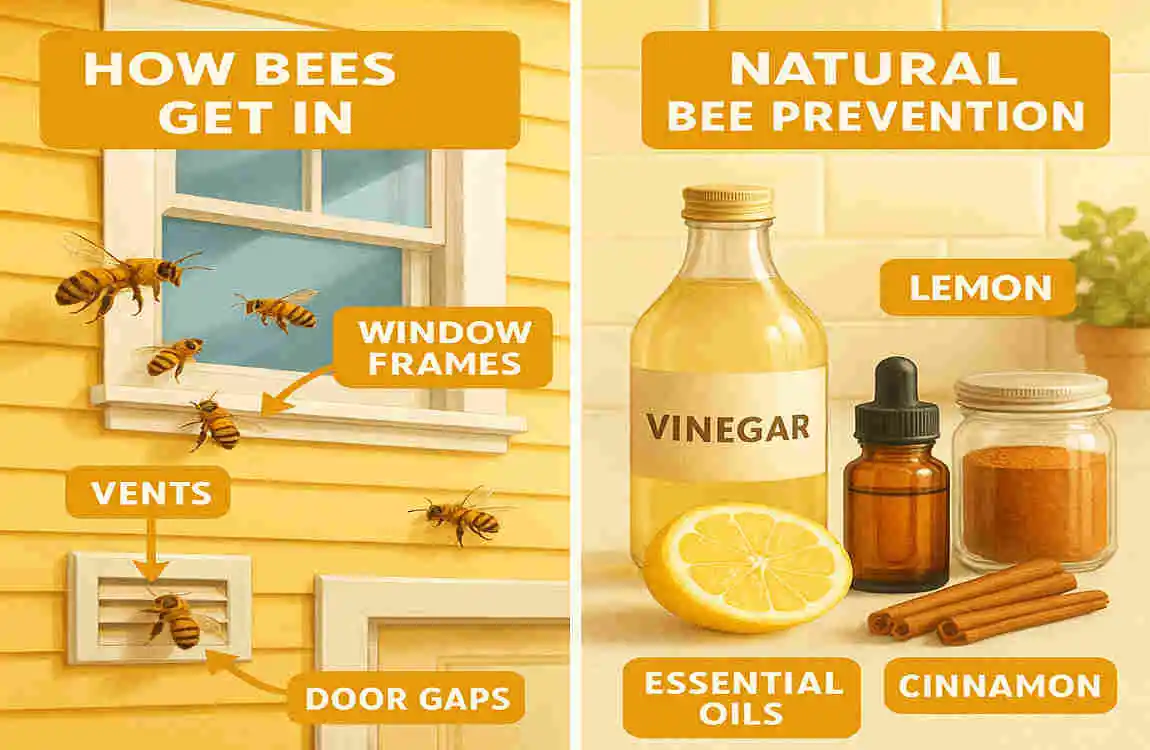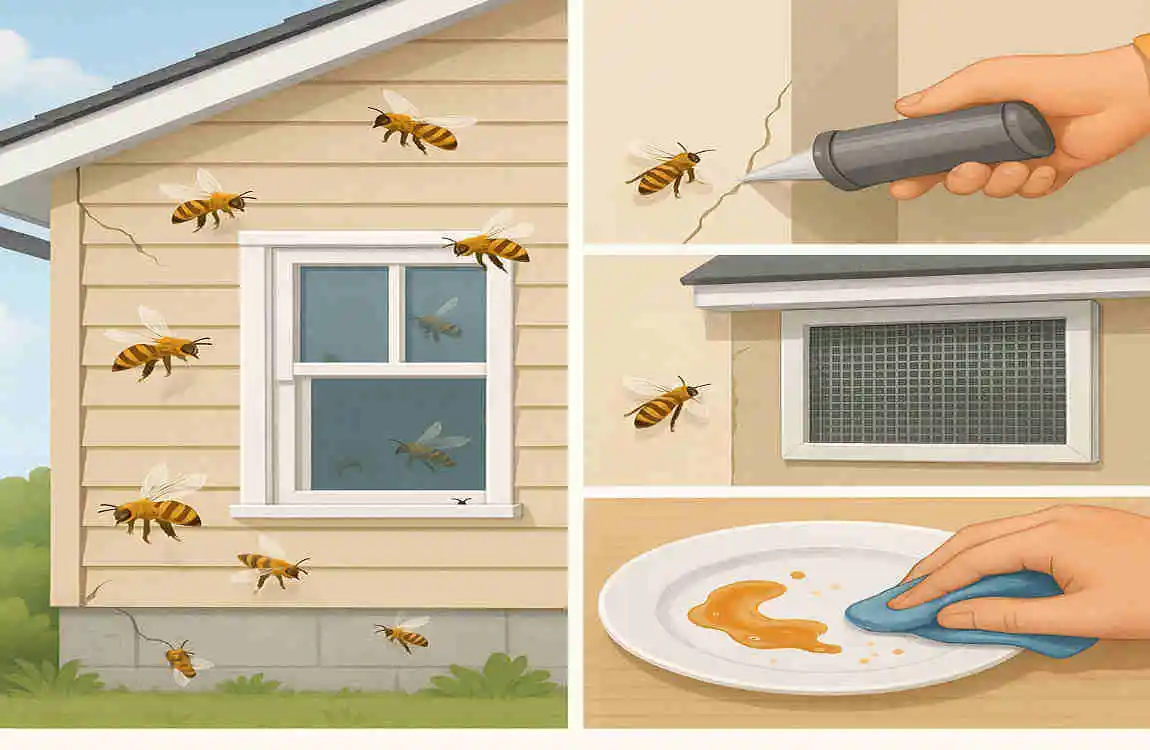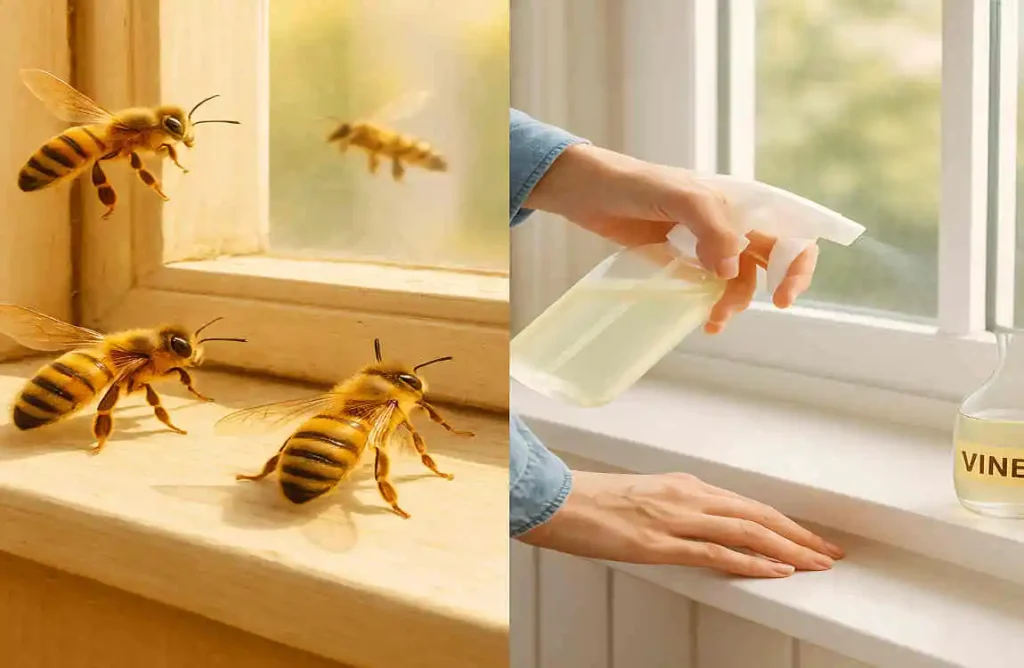Have you ever wondered, “Why do bees keep coming into my house?” If you’ve noticed these buzzing visitors making themselves at home, you’re not alone. Bees entering homes can be more than just a nuisance; they can pose safety risks, cause property damage, and disrupt your peace of mind. But don’t worry — we’ll dive deep into the reasons behind these uninvited guests and provide expert cleaning tips to keep your home bee-free.
Understanding Why Bees Enter Homes

Why Are Bees Attracted to Houses?
Bees are fascinating creatures, and their behavior around homes and urban environments can be pretty complex. Understanding what draws them to cleaning houses is the first step in preventing their entry.
- Seeking Shelter or Nesting Spots: Bees, especially during certain times of the year, are on the lookout for safe places to build their nests. The nooks and crannies of a house seem like an ideal spot.
- Attraction to Light and Sweet Smells: Just like moths to a flame, bees can be drawn to the light emanating from your windows. Additionally, the sweet smells of food or flowers near your home can attract these pollinators.
- Seasonal Behaviors: Bees exhibit different behaviors throughout the year. Swarming, which is when a new queen bee leaves the hive with a group of workers to start a new colony, often leads bees to explore new areas, including homes. Foraging for food is another reason bees might venture inside.
Common Entry Points Bees Use
Bees are resourceful and can find their way into your home through various entry points:
- Cracks and gaps in walls, especially around windows and doors
- Vents and chimneys
- Broken or missing screens on windows and doors
- Openings around utility lines or pipes
How Improper Home Maintenance Attracts Bees
Neglecting home maintenance can inadvertently invite bees into your living space. Leaky faucets, damaged siding, or peeling paint can create attractive nesting spots. Additionally, leaving food residue or sugary spills uncleaned can draw bees in search of a sweet treat.
Identifying Signs of Bee Activity Inside Your Home
How to Recognize Bee Presence Indoors
Spotting the signs of bee activity early is crucial for addressing the problem before it escalates.
- Buzzing Sounds: If you hear a persistent buzzing noise, especially near windows, walls, or vents, it could be an indication of bees inside your home.
- Visible Bees: Seeing bees flying around your windows or congregating near certain areas is a clear sign of their presence.
- Bee Nests or Hives: Discovering a bee nest or hive in your walls, attic, or crawl spaces is a definite sign that bees have made themselves at home.
- Damage or Staining: Look for small holes, staining, or other signs of bee entry points on your walls or ceilings.
Why Ignoring Early Signs Worsens the Problem
It’s tempting to ignore a few bees buzzing around, but doing so can lead to bigger problems down the line. A small group of bees can quickly turn into a full-blown infestation if left unchecked. Additionally, bees can cause structural damage to your home as they build their nests.
Tips for Safely Observing Bee Activity
When trying to identify bee activity, it’s essential to do so safely to avoid provoking the bees:
- Observe from a distance and avoid sudden movements.
- Wear protective clothing, including long sleeves and pants.
- If you’re allergic to bee stings, have an epinephrine auto-injector (EpiPen) nearby.
Expert Cleaning Tips to Keep Bees Out of Your Home
The Importance of Cleanliness in Deterring Bees
Cleanliness is your first line of defense against bee invasions. By keeping your home clean and free of attractants, you can significantly reduce the likelihood of bees entering.
Step-by-Step Cleaning Guide
Here’s a detailed cleaning guide focusing on areas that attract bees:
Removing Food Residues and Sugary Spillages
- Clean kitchen surfaces, including countertops and floors, immediately after preparing or eating food.
- Wipe down dining tables and chairs after meals.
- Vacuum or sweep up any crumbs or food debris regularly.
Cleaning Window Sills, Door Frames, and Outdoor Patios
- Use a mild cleaning solution to wipe down window sills and door frames, both inside and out.
- Sweep or pressure-wash your outdoor patios and decks to remove pollen, nectar, and other bee attractants.
- Consider using a vinegar-based solution, as the smell can help deter bees.
Sealing Trash Bins and Cleaning Frequently
- Ensure your trash bins have tight-fitting lids to prevent bees from accessing food waste.
- Clean your trash bins regularly, both inside and out, to eliminate lingering odors that might attract bees.
Avoiding Uncovered Pet Food or Water Bowls
- If you have pets, make sure to feed them indoors or use covered bowls to prevent attracting bees.
- Clean up any spilled pet food or water immediately.
Recommended Household Cleaning Solutions
When it comes to cleaning solutions, you want to use products that are safe for both your family and the environment. Here are some recommendations:
- Vinegar: A natural cleaning agent that can help deter bees with its pungent smell.
- Lemon Juice: Another natural option that can be used to clean surfaces and repel bees.
- Mild Dish Soap: A gentle cleaning solution that can be used on various surfaces without harming bees.
Tips for Cleaning Up After Removing Bee Nests
If you’ve had to remove a bee nest from your home, it’s essential to clean up thoroughly to eliminate any remaining attractants:
- Wear protective clothing and use a vacuum cleaner with a HEPA filter to remove any remaining bees or debris.
- Clean the area with a mild cleaning solution to remove any pheromone traces that might attract more bees.
- Seal up any entry points to prevent future infestations.
Home Maintenance and Prevention Measures

Inspecting and Sealing Common Entry Points
Regularly inspecting your home for potential entry points is crucial for keeping bees out. Here’s what to look for:
- Cracks and gaps in walls, especially around windows and doors
- Damaged or missing screens on windows and doors
- Openings around utility lines or pipes
- Vents and chimneys
Once you’ve identified these entry points, it’s time to seal them up:
- Use caulk or weatherstripping to seal cracks and gaps.
- Replace damaged screens or Install new ones.
- Use mesh or screening to cover openings around utility lines or pipes.
- Install chimney caps or screens to prevent bees from entering the chimney.
Recommended Materials for Sealing and Weatherproofing
When it comes to sealing and weatherproofing your home, you want to use materials that are durable and effective:
- Caulk: A flexible sealant that can be used to fill gaps and cracks.
- Weatherstripping: A material that can be applied to doors and windows to create a tight seal.
- Mesh or Screening: A fine mesh that can be used to cover openings and prevent bees from entering.
Using Natural Repellents and Deterrents
In addition to sealing entry points, you can use natural repellents and deterrents to keep bees away from your home:
- Citronella: A natural oil that can be used to repel bees and other insects.
- Peppermint: Another natural oil that can be used to deter bees.
- Garlic: Its pungent smell can help keep bees away.
Landscaping Tips to Reduce Bee Attraction
The way you landscape your yard can also play a role in attracting or deterring bees:
- Avoid planting bee-friendly flowers near your home: While bees are essential pollinators, planting their favorite flowers right next to your house can increase the likelihood they’ll come inside.
- Use bee-repellent plants: Certain plants, such as marigolds and eucalyptus, can help deter bees from your yard.
- Keep your yard tidy: Regularly mow your lawn, trim bushes, and remove any debris that might attract bees.
When to Call Professional Pest or Bee Removal Services
While many bee problems can be handled with DIY methods, there are times when it’s best to call in the professionals:
- If you have a significant infestation or multiple nests.
- If you’re allergic to bee stings or have family members who are.
- If the bees are in a hard-to-reach or dangerous location, such as high up on your roof or inside your walls.
Safety Precautions When Dealing With Bees Indoors
How to Avoid Bee Stings and Allergic Reactions
Dealing with bees indoors can be risky, so it’s essential to take precautions to avoid stings and allergic reactions:
- Wear protective clothing, including long sleeves, pants, and gloves.
- Move slowly and avoid sudden movements that might provoke the bees.
- If you’re allergic to bee stings, have an epinephrine auto-injector (EpiPen) nearby.
What to Do If Stung by a Bee
If you do get stung by a bee, here’s what to do:
- Remove the stinger by scraping it off with a credit card or your fingernail. Avoid squeezing the stinger, as this can release more venom.
- Wash the area with soap and water.
- Apply ice to reduce swelling and pain.
- If you experience severe symptoms, such as difficulty breathing or swelling of the face and throat, seek medical attention immediately.
Protecting Family Members, Especially Kids and Pets
When dealing with bees indoors, it’s essential to take extra precautions to protect your family members, especially children and pets:
- Keep children and pets away from areas where bees are present.
- If you have a pet that’s been stung, monitor them closely for signs of an allergic reaction and seek veterinary care if necessary.
- Teach children to respect bees and avoid disturbing them.
Guidelines for Safe DIY Bee Deterrence and Removal
If you decide to tackle a bee problem on your own, follow these guidelines for safe and effective DIY bee deterrence and removal:
- Always wear protective clothing and use caution when approaching bees.
- Use natural repellents and deterrents, such as vinegar or citronella, to discourage bees from entering your home.
- If you need to remove a nest, do so at night when the bees are less active. Use a vacuum cleaner with a HEPA filter to remove the bees and nest material.
- Seal up any entry points to prevent future infestations.
